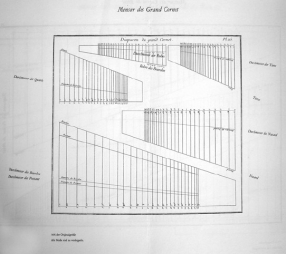Pipe scaling
Pipe scaling determines the general sound character of a rank but also the individial measures of the single pipes, given by the relation of sounding pipe length to diameter (in metal pipes: the width of the pipe on the metal sheet before roling and soldering).
In addition, the pipe foot is added to the sounding length, relevant for secure positioning and wind delivery. The foot soldered to the pipe at the lips has no influence to the sound or pitch but vital for wind supply and statics and therefore often is of thicker metal than the pipe itself.
The sound character of a stop is determined by the relative strength of fundamental and higher harmonics of a pipe. Wider scaling emphasizes the fundamental, narrower scaling enforces higher harmonics.
Diapasons offer a good balance of a prominent fundamental and rather rich harmonics with their ratio of about 15:1 (length:diameter) to 16:1. Wider scales to a ration of about 10:1 are poor in harmonics, offering a strong and carrying fundamental bare of accompanying noise elements, but also rather flute-like and dull. Narrow (c. 20:1) or extremely narrow scalings to about 24:1 produce only weak fundamentals and audible noise elements but a wide range of higher harmonics, in sum a rather soft character, reminding of a string instrument with the typical bowing noises.
Another determining factor interacting with the pipe scaling are the dimensions of the window. In this region the pipe wind flows freely; the longer the passage (the higer the window, approaching a square shape) the more the vorticity before the air flow meets the labial edge. This allows higher wind pressure and thus volume, encourages the fundamental but also the accompanying noise. A wide and narrow window (rectangular shape) produces more harmonics and reduces side noise but tends to overblowing (with a high wind pressure). To prevent unwelcome overblowing and noise orgaan makers have developped special "aids." Already known in the 17th century a common aid were "beards," metal strips upstanding at the narrow sides of the pipe window to help focussing the wind to the labial edge. Later manifold additions for that purpose were box shaped strips, rollers and the "frog" (specific to the stop of the Concert flute/Flute allemand/Flute traversiere/Harmonic flute/Querflöte type).
The appropriate scaling of the pipes matching the wind pressure and the aspired sound character is one of the biggest challenges for the abiblities and sound ideas of an orgen builder,
© Greifenberger Institut für Musikinstrumentenkunde | info@greifenberger-institut.de





